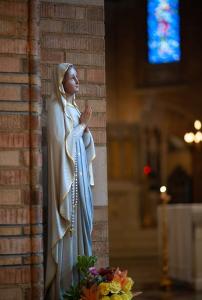Used Books the Rosary in Art by Mary Cooney

The Rosary as we have it today originated in the mid- to late fifteenth century, though legend has it that information technology first arose from St. Dominic, in the early thirteenth century, before falling into disuse. The Rosary was based on prayer traditions using multiple repetitions of the same prayer, at beginning the Lord'due south Prayer, using knots on a rope to keep count.
In ninth century Ireland, the laity began using a string of beads to proceed count of the one hundred 50 Our Fathers they said to mirror the number of Psalms said by the regular clergy of convents in the Divine Office; at that time it was called "Our Lady's Psalter". In the similar practice in the Eastern Church building, the laity normally used knotted rope.
The intention was to mirror the 150 Psalms. In the first few centuries, some said 150 Our Fathers, some 150 Hail Marys, some 150 praises to Jesus, some 150 praises to Mary. By the fourteenth century, cursory meditations were attached to each repetition of the primary prayer, there being sets of 50, of 100, and of 150.
The Angelic Salutation in the East
Contrary to pop belief, the Angelic Salutation is non just a Western aberration.
Well-nigh all Eastern translations into English render the first word equally "Rejoice!" rather than "Hail!". St. Jerome, who translated the Vulgate from Greek into Latin, was far from existence a linguistic savant. The Greek discussion "Chaire" does mean "Rejoice" just equally "Ave" does hateful "Hail". Where Jerome has "gratia plena", or "full of grace", the original Greek has the word "kerecharitomene", or "favored one".
In the Due east, the two sentences from Luke joined equally one were used in a regular prayer as early on every bit the fifth century. In fact, it has been a function of the Liturgy of St. James of Jerusalem, or St. Mark of Alexandria, of St. Basil the Great, and of the Abyssinian Jacobites. Some Eastern scholars and theologians surmise that its utilize goes dorsum to the fourth century, or dates back to the introduction of the Third Ecumenical Quango at Ephesus in 431.
In composing his formula for the Sacrament of Baptism in 647, St. Severus, Patriarch of Alexandria, included the prayer thus: "Peace exist with thee, Mary, favored one, for the Lord is with thee. Blessed art one thousand among women and blest is the fruit of thy womb, Jesus Christ. Holy Mary, Theotokos, pray for us sinners. Amen". This is the first example known of a petition being added to the end of the Angelic Salutation, but it never spread in the Eastward.
More Almost The Rosary in the Cosmic Church
In 1198, the Lodge of the Nearly Holy Trinity for the Redemption of Captives began maxim the Rosary of the Holy Trinity on a chaplet of three groups on nine beads. The prayer effectually which the beads was structured is the Trisagion.
In 1233, the Guild of the Servants of Mary, known as the Servites, instituted their rosary known as the Rosary of the 7 Sorrows of Our Lady. The class is used with a chaplet of seven decades.
In 1422, the Gild of Friars Minor (the Franciscans) established the Rosary of the 7 Joys of Our Lady, besides known as the Franciscan Crown. This rosary is said with seven decades of Hail Marys, book-concluded by an Our Father and a Pocket-size Doxology, with two more Hail Marys added at the end.
In 1851, the Vatican approved the Chaplet of St. Michael, consisting of 9 groups of three small beads separated past a large bead. The prayers used are the Paternoster and the Ave Maria.
In 1912, the Order of the Visitation instituted the Rosary of the Five Wounds, said on a chaplet of v decades only with different prayers.
In 1935, the Sisters of Our Lady of Mercy instituted the Chaplet of Divine Mercy, said on a beads of five decades but using special prayers.
In 1983, the visionaries at Medjugorje, Croatia, introduced, or revived, a form known as the Jesus Rosary. This consists of seven meditations of 5 beads each, earlier which the mystery and intention are said aloud, followed by five Our Fathers, terminal with this collect: "O Jesus, be strength and protection for u.s.a.". At the finish, vii Minor Doxologies are recited.
The Rosary is cherished in the Catholic Church. Archbishop Fulton Sheen did say,
"The rosary is the book of the blind, where souls see and there enact the greatest drama of honey the world has always known; it is the book of the simple, which initiates them into mysteries and knowledge more satisfying than the education of other men; it is the book of the aged, whose optics close upon the shadow of this world, and open up on the substance of the adjacent. The ability of the rosary is beyond description."
billsonlearallings.blogspot.com
Source: https://www.patheos.com/blogs/teainlaurikasgarden/2022/02/the-rosary-the-great-prayer/